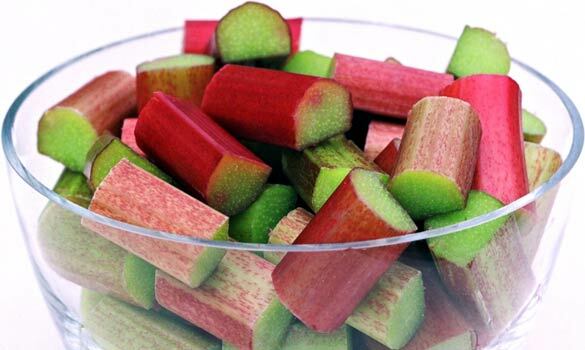Diet with glomerulonephritis
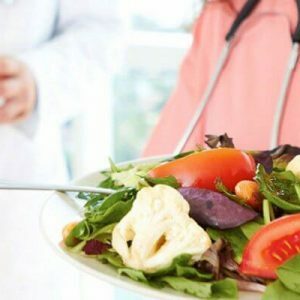
One of the most important treatment points for any disease is proper nutrition.In addition to standard drug therapy, doctors who closely consider their patients are strongly encouraged to change the habitual diet and develop a new program that includes a special composition of foods and eating norms.The diet, selected especially for each clinical case, helps to cope faster with the disease, facilitating the work of the body as a whole and supplying the organs and tissues with the necessary vitamins and minerals.
In addition, compliance with the diet helps restore metabolic processes, regulate the absorption of nutrients and the excretion of harmful substances, contributes to the acceleration of regeneration processes.
Table of contents: Features of the diet for glomerulonephritis Diet №7 for kidney pathologies Diet for acute glomerulonephritis Nutrition for chronic glomerulonephritis What can you eat with glomerulonephritis?What can not be eaten?Features of the diet for glomerulonephritis
The big problem with glomerulonephritis is that it not only does not manifest itself in the early stages of development, it is able for many years to slowly deteriorate the body's condition without causing suspicion neither of the pathology carrier nor the doctors at standardAnalyzes.
It is possible to detect glomerulonephritis using diagnostic tools only when the pathology is at a rather dangerous stage.To provoke the disease there may be significant hypothermia, non-observance of norms and rules of personal hygiene, sometimes it becomes a consequence of previously transmitted diseases of a viral or bacterial nature.
In order to make the right diet, the doctor should take into account not only the specific course of the disease in a particular patient, but also calculate the rate of fluid intake.It should be such that there is no unnecessary burden on the diseased kidneys. They should remain in relative rest, while still maintaining their basic physiological functions.
During the treatment of glomerulonephritis, it is necessary to exclude from the everyday menu those products that negatively affect tissues and organs, require the body's efforts for digestion and excretion, promote the retention of fluid in the body and impair the ability of organs to absorb useful substances from food.
Diet №7 for kidney pathologies
Most often this diet is used during remission, when the disease manifests itself not so brightly.
The main principle is to limit the intake of protein, salt and other substances in the diet that can increase the burden on the kidneys.It will also be necessary to eliminate the burden on the cardiovascular and nervous systems.This is the main difference between diet number 7 and others - it is forbidden to eat meat, even meat broths.Under the ban are dairy products of any kind, as well as all kinds of fruits, vegetables and herbs, containing even minimal amounts of essential oils.
By quantity of energy value, the amount of calories consumed per day should be no more than 2750-3150. By calculation of other components per day, the body can receive:
- 80 g protein;
- 90 g of fat;
- 400-500 g of carbohydrates;
- Sodium Chloride is not more than 7 g.
Products included in the main menu are used exclusively in strongly crushed, well-cooked form.We accept food at least 5-6 times a day, in small portions.
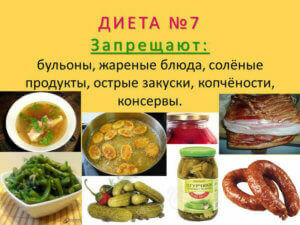
Diet for acute glomerulonephritis
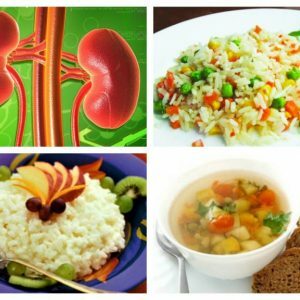 Acute renal failure during an acute attack of glomerulonephritis can be significantly reduced in those cases when the required diet is observed. The right menu during this period ensures the unloading of protein metabolism, contributes to increased urinary fluid outflow, and also speeds up blood circulation and other metabolic metabolic processes. Thus, lowering of blood pressure is ensured.
Acute renal failure during an acute attack of glomerulonephritis can be significantly reduced in those cases when the required diet is observed. The right menu during this period ensures the unloading of protein metabolism, contributes to increased urinary fluid outflow, and also speeds up blood circulation and other metabolic metabolic processes. Thus, lowering of blood pressure is ensured.
The energy value of the daily menu is reduced to 2,200 kilocalories due to the reduction in the amount of products containing fats and carbohydrates .Nutrition of the patient should contain a high percentage of vitamins and minerals, but you should take into account that eating foods that promote kidney irritation is strictly prohibited.It will be necessary to limit the patient in the use of liquid.Ingredients:
- proteins - 20 g;
- fats - 80 g;
- carbohydrates - 350 g;
- salt - no more than 2 g.
The diet is calculated for approximately 7 days.The use of fried foods is strictly prohibited.Only boiled and cooked for a couple.
Nutrition for chronic glomerulonephritis
Sometimes inflammation of the renal glomeruli passes into a chronic phase, characterized by alternating stages of exacerbation and remissions.Symptoms are very rare.
In a hospital environment, people who are taking a course of treatment are recommended to adhere to the diet 7b, which is an alternation of standard nutrition in renal pathologies and fasting days.
Such a diet is more gentle, unloading days can be sweet or even compote.However, for the fastest recovery and lowering the pressure on the organs, it is best to conduct rice unloading days.
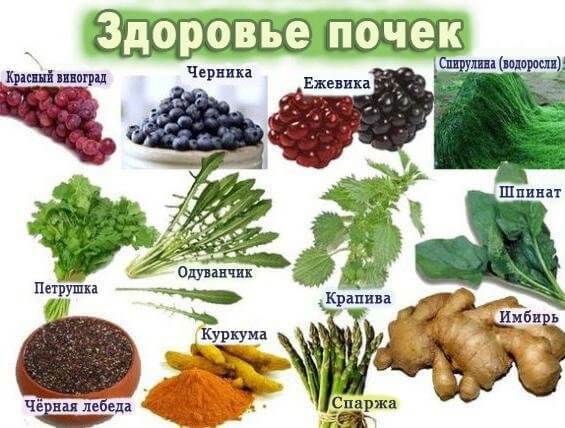
During the treatment, smoked products are strictly forbidden, salty and seasoned with spices.It is acceptable to eat fresh fruits and vegetables .Instead of water, it is better to drink a broth of dogrose, which is known for its high content of vitamin C. The amount of ingested liquid should be such that it is about 500 ml more than the urine released per day.This can also help the use of vegetable soups.
After discharge from hospital, the patient changes the diet several times.The energy value of the daily menu is now 320 kilocalories.
Ingredients:
- Proteins - 50 g;
- fats - 90 g;
- carbohydrates - 450 g;
- sodium chloride - up to 8 g.
Food also remains fractional, no less than 5-6 times a day.
The use of meat and fish broths is limited, as they can give an additional burden to the kidney glomeruli and provoke irritation.
What can I eat with glomerulonephritis?
Individual menu is selected exclusively by a specialist doctor. Depending on the stage of the disease, risk factors, peculiarities of its course and personal preferences of the patient, the following products can be added to the menu:
- saltless bread and flour products with a low amount of yeast;
- hospital biscuits;
- fresh pancakes and fritters;
- vegetable broths and soups;
- low-fat meat and poultry steamed;
- boiled fish with low fat content;
- dairy products, but in very small quantities;
- any cereals;
- potatoes;
- dried fruits;
- jam and jam with low sugar content;
- herbal teas.
You can not add any spices to the dishes, but during the improvement you can add a few fresh herbs, carefully watching how the patient will feel after eating such foods.
Each of the allowed menu items is added gradually, one at a time.If deterioration was noted, the product added earlier is immediately again excluded from the food.
What can not be eaten?
At any stage, it is strictly prohibited:
-
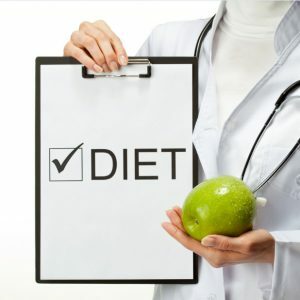 any baking containing salt;
any baking containing salt; - milk soups;
- soups from meat and fish;
- fat;
- fried, smoked, dried and dried products;
- fast food;
- beans of all kinds;
- onion, garlic;
- radish, radish, turnip;
- chocolate;
- coffee;
- sweet soda.
Eating these foods can cause severe deterioration of the condition, exacerbation of the disease and additional strain on the body due to irritation of other organs and tissues.During treatment, it is better to have patience and not eat them at all.
Konev Alexander, internist

